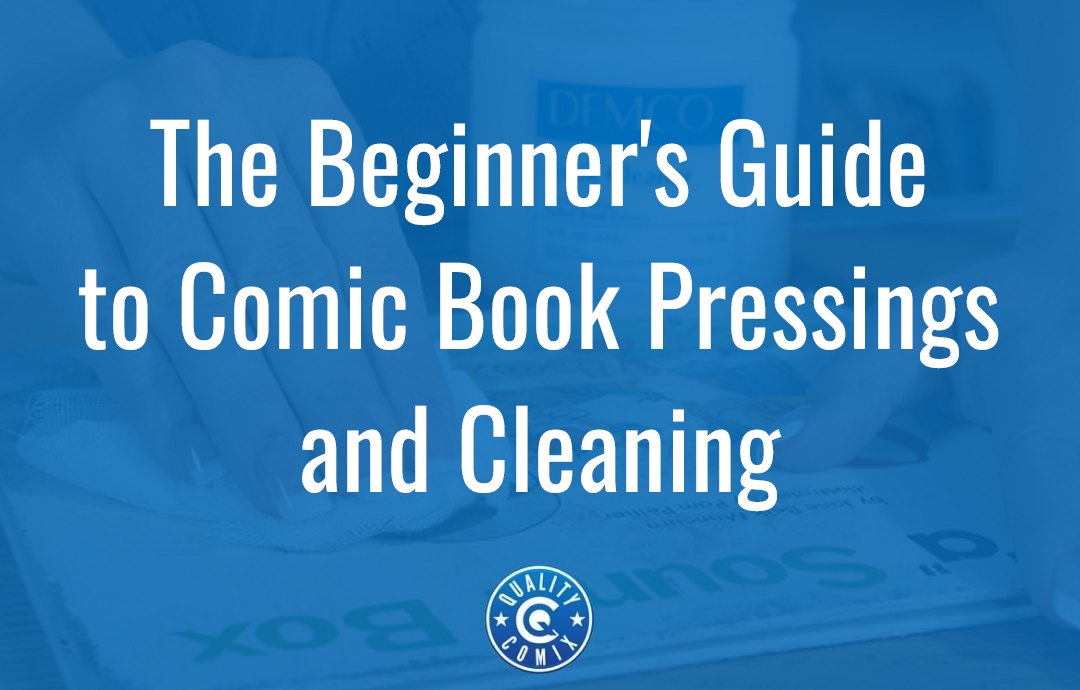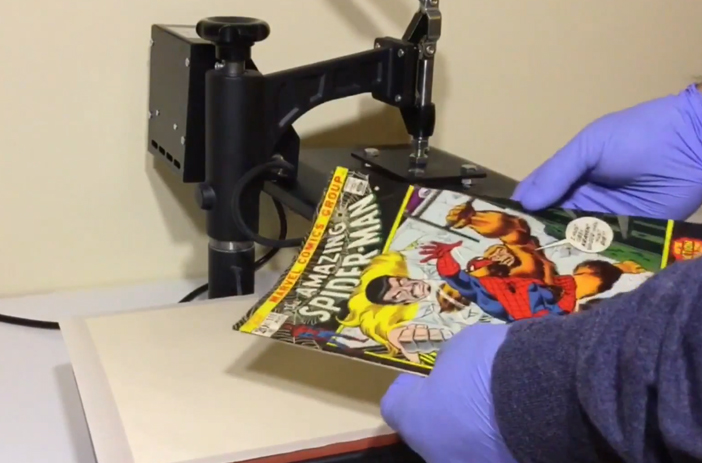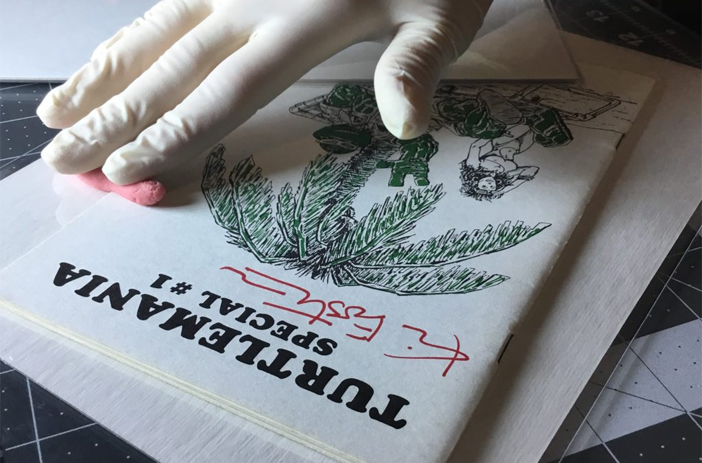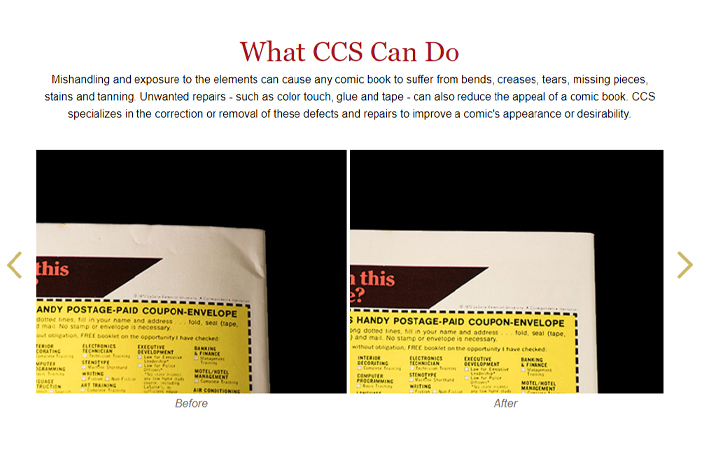
The condition is everything when you're looking into grading and selling comics. It's difficult to find older and more popular books in good or excellent condition, so those that have withstood the ravages of time (and the interest of children at the time) are near-priceless. No wonder some of the most popular books in good condition sell for six and seven figures!
Many things can damage a comic over time. There's damage from reading and owning a book and not caring for it. There's damage from dirt, humidity, entropy itself, and of course, the stray pencils of the kids who read it. Unless you bought the comic, stored it away carefully after reading it once, and kept it isolated from the environment, chances are it has built up some dirt, some bends or creases or wrinkles, and who knows what else.
You can't restore some damage to comics. A comic book that landed in a puddle is unlikely to return to its former glory. You can repair other damage in a way that decreases value; it becomes beneficial as a reading copy or a low-cost collector's item, but it will never be graded highly or worth the top-end money. These kinds of repairs use replacement paper, archive tape, fresh staples, and other techniques used in preservation.
Some damage, though, can be removed (carefully, of course) to increase a book's overall condition and quality. With careful cleaning and pressing, a comic can be improved, graded higher than its original condition, and consequently can be worth more.
So what is pressing and cleaning? Is it worth doing? Can you do it yourself? Let's dig in.
What Is Cleaning and Pressing?
Cleaning and pressing is a relatively new process (formally recognized and developed over the last 20 or so years) that aims to improve comics' condition without adulterating or modifying them.
The process of cleaning and pressing a comic is a restorative process. However, it's not generally considered restoration in the sense that it would get a restored label rather than a standard label in grading. Comics that are correctly cleaned and pressed will typically not encounter degraded valuations.

There are two reasons for this:
- It's not always detectable. A book that has been adequately cleaned and pressed will look normal. There are no residual signs that a book has been cleaned and pressed unless it is done poorly and damages the book.
- It doesn't use restorative ingredients. Cleaning doesn't involve chemicals, and there are no added staples, paper, tape, or ink; it's just the original book, some humidity, and some weight.
The technology used to clean and press comics has improved over the years, but it's not perfect for every book. Older books can deteriorate when exposed to the process or may have blemishes that you can't remove.
Cleaning and pressing is a three-step process. Here's how it works.
Step 1: Dry Cleaning
The first step involves cleaning the comic. Much like how you would get a fancy suit or dress dry cleaned rather than throwing it in your home washer, comics get dry cleaned to remove dust, dirt, small grit, and minor marks, stains, and blemishes. The specific tools used will vary depending on the age and materials of the comic being cleaned.
Dry cleaning uses a series of tools to remove dirt, stains, and residue from the pages of your book.
It usually starts with a cotton pad to wipe away grit, dirt, crumbs, and other stuff that can get trapped between the pages. No chemicals or other contaminants are used in this process, just simple mechanical work.
The second step is usually to use a dry eraser. Note that this is not typically a standard pencil eraser; instead, it's something more like a Magic Eraser or (the go-to with many pros) the Absorene eraser.

They're rubber sponges that are soft enough to be used on comic pages but tough enough to remove surface-level grime and residue from your comic's pages. This method can ease, lighten, or even remove some stains and surface-level damage like pencil marks, but it won't be able to remove stains that saturate the paper of the pages.
The third step is an eraser putty, which removes any other residue and grime that may be left over from the rest of the process. This process leaves your comics in as good a condition as possible before the following steps, and it can enhance the appearance of your books.
More advanced dry cleaning may use even more tools and multiple stages, going from minimally invasive devices to more abrasive and harsh tools depending on the comic's value, condition, construction, quality, and the kind of blemish being removed.
You can see a more detailed example here.
Finally, note that cleaning is not a complete restoration. Missing ink is not replaced, missing pages are not replaced, worn staples are not swapped with new ones; you get the idea.
Step 2: Humidification
The second step of the process is humidification. While you might think that adding moisture to a comic is damaging, it's all about careful and controlled application.
Adding humidity means placing the comic in a sealed container, with moisture, in a temperature-controlled environment, for a specific duration. The amount of humidity, temperature and time vary depending on the materials the comic is made of and how old it is.

Regardless of the specifics, the goal is to apply enough humidity to soften the fibers of the paper. This process alone will remove some minor divots and wrinkles and primes the book for pressing.
Not all books require pressing humidity, but many comic books could benefit from this process. Part of proper cleaning and pressing is to understand when to use which techniques.
Step 3: Pressing
The final step is the actual pressing of the comic. Depending on who is doing the pressing, this can be as simple as putting the book between a couple of flat plates and putting weight on top, or it can involve dividing pages with inserts, protecting specific elements of covers, and using large, fancy machines to deliver carefully, even pressure.
Pressing usually adds heat (depending on the material) to soften fibers, press them flat, and then allow them to cool and dry into their new configuration. For obvious reasons, any grime or grit needs to be removed first, or pressing will embed it into the book, making it more challenging (if not impossible) to remove entirely.
Card stock is inserted around uneven inclusions, like postcards within the book, to prevent their imprint from pressing into adjacent pages and to prepare the comic for pressing.

A backer board is used in the centerfold to keep the pages separate and the center crease defined. Silicone pads and silicone release paper help protect the covers from the press itself. Further inserts can protect specific pages or damaged sections, as well.
Sometimes, stubborn creases and damage will reoccur (called reversion) if the paper "remembers" the crease and the pressing didn't remove it. Further pressing can prevent this from happening again. If your comic has a lot of deep wrinkles, you may want to ask the comic pressing company what they recommend before you send your book in for pressing.
The entire process can take several days up to a couple of weeks. Cleaning often takes several hours, humidification can take anywhere from a few hours to half a day, and pressing can require anywhere from half a day to a week to do correctly.
Do Collectors Hate Pressing and Cleaning?
Opinions vary. Some people consider any tampering with a book, at all, to be a restoration that you must disclose as such. Others believe that cleaning and pressing are not invasive or misrepresentative of the book's condition and that restoration only includes using chemicals or other materials (or replacement items, pages, and other syntheses of multiple books.) When it first became popular, users fought many a flame war on the battlefield of internet mailing lists, BBSs, forums, and other venues.
These days, opinions have generally settled down. Major grading companies like CGC even offer cleaning and pressing services, and it's ubiquitous to clean and press comics before getting them graded or selling them.

Think of it this way.
If you have a comic with some dirt on it and an edge stain that grades at a "7" and is worth $10,000, but you can pay $40 to have the dirt and stain removed, which bumps the grade to a "9" and the value to $40,000, would you do it? Of course, you would.
When done correctly, cleaning and pressing are not detectable. It simply improves the condition of a book, such that it looks like it has been appropriately stored for more of its life. If no one, not even professionals, can tell that the book has been professionally cleaned and pressed, how can anyone be mad about it happening?
Can You Clean and Press Comics Yourself?
Yes, but it's not advised on valuable comics, and you must be very careful.

There are many ways that the process can go wrong:
- The wrong materials used in cleaning can tear pages, remove ink, or grind in blemishes even deeper. Permanent damage is possible, especially if you aren't using the right tools for the right kinds of paper.
- Humidification is also quite dangerous. Using moisture on the wrong kind of paper (especially brittle comics) can ruin it.
- Using non-distilled water can lead to stains and mineralization. If a catastrophe happens, spilled water can be devastating.
- Pressing, too, can go wrong.
- Staples can pop, creases can be made worse, imprints and indents and pebbling can all occur, and more. Some of this is reversible, but some aren't.
- And, of course, you need the right tools for the job. Even a bare-bones DIY setup will cost a few hundred dollars to get started and requires a decent amount of consumables you'll use for each book you clean and press.
- Taking shortcuts can damage books.
If it sounds like something you're interested in, there are many excellent how-to guides to get started.
Otherwise, it's generally best left to professionals. In many cases, DIY jobs end up permanently damaging a comic book's value. Too many parts of this process could go wrong, and if your comic book is valuable, it's not worth attempting this delicate process yourself.
How Much Does Professional Pressing Cost?
Cleaning and pressing costs vary depending on factors, including who you have to do it, how old the book is, any special considerations with the book, and even whether or not it will be graded afterward.

For example, CGC charges:
- $15 for modern books under $400 in value.
- $30 for pre-1975 books under $400 in value.
- $70 for books between $400 and $1,000 in value.
- $100 for books between $1,000 and $3,000 in value.
Even more valuable books, books with special considerations, and comics requiring a rapid turnaround time will have additional charges.
These groups are generally the price ranges you're looking at, barring exceptional circumstances. Some companies may charge more or have a slower or faster turnaround time; some of it varies by the volume of work and the type of comic you send in.
Should You Get Your Comics Cleaned and Pressed?
This decision ultimately comes down to you.
If your comics have minor blemishes and folds, cleaning and pressing can increase their condition.
If you intend to get your books graded to increase their sale value, cleaning and pressing is an excellent first step.

Most grading companies offer cleaning and pressing before grading just as a matter of course unless there's a reason why a book shouldn't be tampered with.
If your comics have certain kinds of damage, like rusty staples, brittle pages, or a cover page that is barely hanging on, cleaning and pressing may not be worth it. There's always the risk of further damage during the cleaning, especially the pressing process, and the potential benefits don't outweigh the risk. It's also always possible that the book is in a condition where cleaning and pressing won't improve the overall grade.
Cleaning and pressing can increase the value of many comics but can be risky for specific books. It's best to talk to a professional if you're interested in having your books cleaned and pressed.
If you'd rather sell them, feel free to contact us; we're more than happy to walk you through the entire process and will even buy your comics if you accept our offer! You can request a free valuation on this page with no strings attached. It can't hurt to know the true value of your comic books; it just may surprise you!

![[Guide] Where is the Best Place to Get Your Comics Graded?](https://www.qualitycomix.com/images/size_f/news-000079.jpg)

